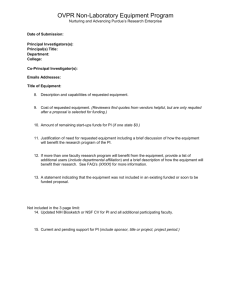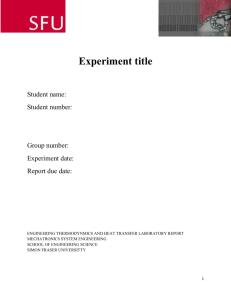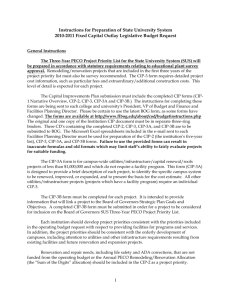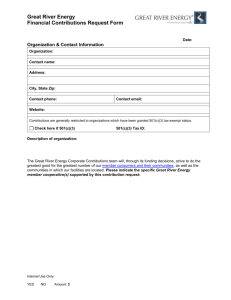1.2016-17-CIP-General-Instructions_FINAL
advertisement
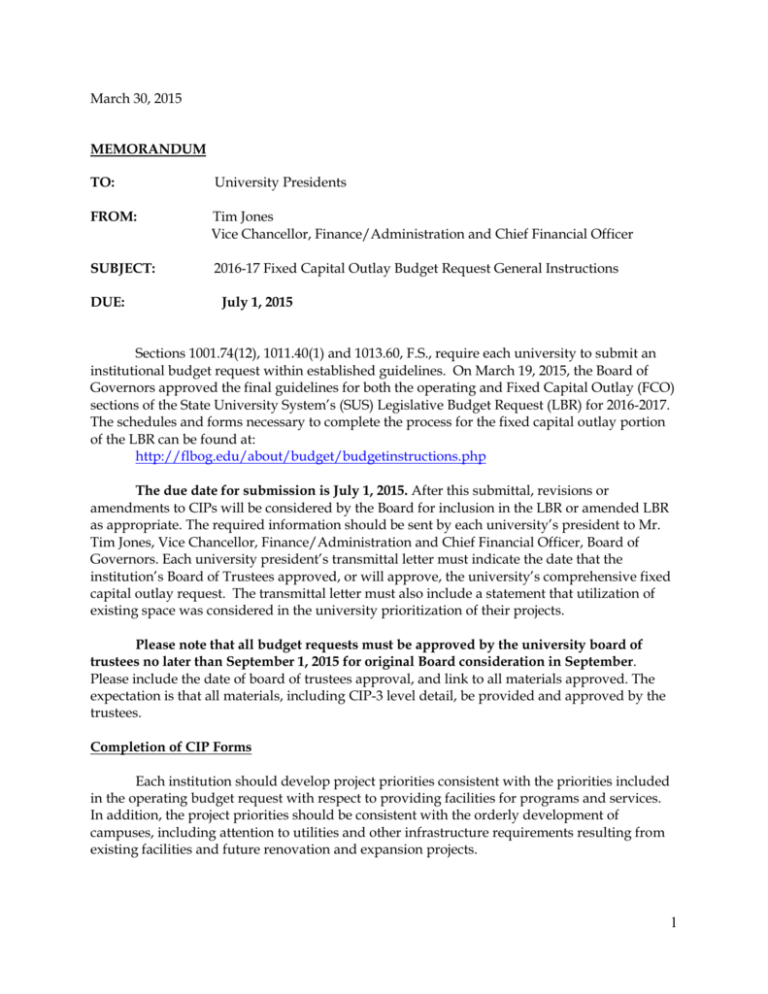
March 30, 2015 MEMORANDUM TO: University Presidents FROM: Tim Jones Vice Chancellor, Finance/Administration and Chief Financial Officer SUBJECT: 2016-17 Fixed Capital Outlay Budget Request General Instructions DUE: July 1, 2015 Sections 1001.74(12), 1011.40(1) and 1013.60, F.S., require each university to submit an institutional budget request within established guidelines. On March 19, 2015, the Board of Governors approved the final guidelines for both the operating and Fixed Capital Outlay (FCO) sections of the State University System’s (SUS) Legislative Budget Request (LBR) for 2016-2017. The schedules and forms necessary to complete the process for the fixed capital outlay portion of the LBR can be found at: http://flbog.edu/about/budget/budgetinstructions.php The due date for submission is July 1, 2015. After this submittal, revisions or amendments to CIPs will be considered by the Board for inclusion in the LBR or amended LBR as appropriate. The required information should be sent by each university’s president to Mr. Tim Jones, Vice Chancellor, Finance/Administration and Chief Financial Officer, Board of Governors. Each university president’s transmittal letter must indicate the date that the institution’s Board of Trustees approved, or will approve, the university’s comprehensive fixed capital outlay request. The transmittal letter must also include a statement that utilization of existing space was considered in the university prioritization of their projects. Please note that all budget requests must be approved by the university board of trustees no later than September 1, 2015 for original Board consideration in September. Please include the date of board of trustees approval, and link to all materials approved. The expectation is that all materials, including CIP-3 level detail, be provided and approved by the trustees. Completion of CIP Forms Each institution should develop project priorities consistent with the priorities included in the operating budget request with respect to providing facilities for programs and services. In addition, the project priorities should be consistent with the orderly development of campuses, including attention to utilities and other infrastructure requirements resulting from existing facilities and future renovation and expansion projects. 1 Renovation and repair needs, including life safety and ADA corrections, that are not funded from the operating budget or the Annual PECO Remodeling/Renovation Allocation (the “Sum of the Digits” allocation) should be included in the CIP-2 as a specific project priority. The Facilities Enhancement Challenge Grant Program (FECG) was suspended by the Legislature in 2011; therefore, no data on FECG projects are to be included in the 2016-17 CIP submission. However, if applicable, please provide a list of any projects for which donor funds have been returned, projects that have been completed, or projects no longer requesting to be matched. Current PECO revenue projections for the next three fiscal years provide funding for relatively few projects. Accordingly, within the limited funding available, resources should be directed towards survey recommended projects only. Separate sections on the CIP-2 have been provided for future projects which require state funding or may be funded from non-state sources. Proposed projects being planned with mixed funding sources are encouraged, and non-state sources described on the CIP-3 and should be split between applicable categories, as necessary. Two (2) hard copies of the institution’s completed documents must be provided in a three-ring binder. In addition, one electronic copy of the forms, in original format (Word or Excel only - please no PDF’s!), must be provided via upload to the Board of Governor’s SUDS Portal. Failure to use the provided forms can result in inaccurate formulas and old formats which may limit staff’s ability to fairly evaluate projects for suitable funding. ALL current forms may be found here: http://flbog.edu/about/budget/budgetinstructions.php Additional details regarding form modifications and requirements are located in the enclosed instructions. If your staff have questions regarding the submission of the required information, please have them contact Mr. Kenneth Ogletree at (850) 245-9254, or Ms. Teira E. Farley at (850) 245-0059. CIP-1, Narrative Overview CIP-1, A Narrative Overview, is not being required for 2016-17. CIP-2, Summary of Projects The CIP-2 form includes four sections. All columns within the form are to be completed with the appropriate information requested in the format provided. Each section should be separately prioritized. The first section, ‘PECO-Eligible Project Requests,’ is the traditional PECO eligible project request. Only projects with current survey recommendations should be included here. The second section of the form, ‘CITF Project Requests,’ has been created to capture CITF projects. 2 The third section of the form, ‘Requests from Other State Sources,’ should include any capital projects that may not be PECO eligible but will require some state funding, (i.e. General Revenue). This is also the portion of the form for future planned PECO eligible projects that do not have a current survey recommendation. The final section of the form, ‘Requests from Non-State Sources, Including Debt,’ is designed to provide a snapshot of University plans for Capital Improvements that may not be captured in other portions of the form. The University should summarize their 5-year plan for debt issues, as well as any large development projects or public/private partnerships. The use of funds from sources such as industry partnerships and donations should be described here as well. Please make every effort to complete the full five years for this section. This section of the form does not need to be prioritized. Funding will be requested for institutional survey recommended PECO projects in the following priority order: A. Maintenance Projects a. Funding for Remodeling/Renovation/Maintenance/Repair will be requested from PECO pursuant to formula as required by Section 1013.64(1)(a), Florida Statues b. Critical Deferred Maintenance B. System and Continuation Projects a. Projects funded by the Legislature in the amount and in the year as last included on the Board adopted three year list b. Projects funded by the Legislature, but not on the Board adopted three year list c. Projects that require additional funding to complete C. Renovation Projects a. Utilities/Infrastructure/Capital Renewal/Roofs Needs b. Renovation and Remodeling projects to meet current space needs, Structural/Mechanical repairs, replacement of existing facilities which have a survey recommendation D. Strategic Projects a. Land or Building Acquisition in accordance with university board of trustees adopted master plans b. New facilities, as needed to meet instructional and support space needs E. Legislative Authorizations a. Required legislative authorizations will be requested for externally funded projects as proposed by the universities, in accordance with Section 1010.62 and 1013.78, Florida Statutes It is anticipated that the Board of Governors will again receive System-level Critical Deferred Maintenance funding for both the 15-16 and 16-17 years. Institutions will be requested to provide additional information in support of the 15-16 allocation, and 16-17 request in 3 connection with the June 2015 Board of Governors meeting. Each university will be asked to A) Update prior expenditures from 14-15; B) Allocate 15-16 funding to specific planned projects; and C) Request additional funding for 16-17. This item will be further explained at the Spring Planner’s Meeting. All institutional projects which, in total or in part, have an academic or academic/administrative support purpose should be listed in a single priority order which includes every requested project for all University locations. (Each university must incorporate utilization data as a factor in prioritization of university CIP funding requests to the Board of Governors). The institution may also submit a separate CIP-2 for other locations as needed. Priority numbers and specific reference to survey approval (date and recommendation number) are to be listed in the appropriate column on the CIP-2. Columns on the CIP-2 are identified to collect essential information about each project and are to be completed. CIP-3, Short-Term Project Explanation This multi-part form is to be completed for each project that appears on the college and university’s project priority list (CIP-2). Remodeling is defined as the conversion of space to a different use or configuration. Major renovation projects that are primarily restorative and aesthetic, as opposed to remodeling, are also to be presented on this form. While the CIP-3 was designed to support requests for building projects, the narrative section should also be used to provide a description of facilities problems to be remedied by capital projects that expand campus-wide utilities/infrastructure systems. The information on all components of the CIP3, sections A through D, must be consistent. CIP-3, A - Narrative Description Again, it is essential that all project information in the narrative description be updated, AND approved by your university Board of Trustees. This section is devoted to defining the purpose, need, scope, and the relationship of the project to university objectives. This section should be succinct, including only the significant information and justification. A detailed description of the programs to be supported by the project is not required. The greatest emphasis should be placed on problems resulting from inadequate facilities, solutions considered, and methods used to determine space needs. Any construction costs included in the project budget that are not directly related to the facility, such as extra utilities capacity or lines, site development, roads and parking, etc. should also be briefly explained. The explanation should include a description of the basis used to develop the cost estimate. Specific strategies for addressing energy efficiencies and sustainability issues should be summarized. References to the level of LEED certification or equivalent certification levels should be addressed. The narrative must include a specific reference to the Educational Plant Survey approval (survey date and recommendation number in the Educational Plant Survey report), or the status of a request for a survey if requested for projects in future years. In addition, 4 an explanation must be provided if the referenced survey recommendation does not match the type and amounts of space requested on the CIP-3. CIP-3, B - Project Description The project description section on the upper portion of the second page of the CIP-3 is devoted to the reporting of construction cost and occupancy date. The construction amount should include all costs to be included within the construction contract for a complete and operational project/facility such as site work, parking, and roads for the immediate site area, utility connections, telecommunications/communication requirements, and site/area landscaping. Each type of space (classroom, teaching lab, etc.) should be listed separately in order to report differences in the efficiency factor. Only projects containing space types consistent with the 9 Educational and General (E&G) categories are eligible for PECO funding requests. Funding of space other than the 9 E&G categories should not be included in the PECO portion of the CIP-2. Definition of Additional/Extraordinary Costs: The intent of this category is to describe and fiscally account for those construction costs that may be incurred in conjunction with a particular project, that are unique to that project, on that particular site, and are not assumed to be a part of the Board average cost for a particular building type. These costs would not necessarily be expected to apply should the facility be built again on another site. The basic building cost assumes inclusion of the building and site cost that are associated with the building and around the building including the normal hook-up and connecting requirements for utilities. However, if the cost for these necessary items becomes extensive due to site conditions, utility hook-up locations, or other conditions being associated with the project that are not typically associated with the building type, then the items should be identified as extraordinary (i.e. extensive long piping runs for connectivity, or extensive relocation of existing utilities because of the building site). CIP 3, C - Schedule of Project Components This section is devoted to the reporting of funds requested by the type of cost. Project costs not normally included within a construction budget for a single operational facility should be reported in this section. These costs should be reflected by year and must correlate with the year in which funding is requested for the specific facility (ies) to be served. Examples of such costs are professional inspection services, on-site supervision, artwork, and permitting fees. The Planning Phase (P) of a project should include all costs for professional design services. The Construction Phase (C) of a project should include all costs associated with contracts for construction. The Equipment Phase (E) should include all costs associated with loose furnishings and equipment. 5 When a project results in square footage being added to the institution’s inventory and the facility includes public space pursuant to s. 255.043, F.S., artwork funds must be also requested. These funds should be included in the construction funding year. Equipment funds should be requested for items that are eligible for furnishings and equipment pursuant to s. 1013.64(4)(a), F.S . Fixed equipment such as fume hoods and essential communication connectivity that are necessary to make a building functional must be included within the estimated construction cost rather than as furnishings and equipment. The energy efficient equipment line is to be left blank unless special equipment is included within the project such as solar water heating. The normal energy efficient equipment and management systems are considered to be part of the construction cost per GSF. The standard project contingency is five percent. The need for a contingency amount greater than the standard five percent should be explained in Part I - the Narrative Description section of CIP-3. The sections Appropriations To-Date and Projected Costs Beyond CIP must be completed. All additional sources of funds, both appropriated and/or anticipated from other sources, must be identified. CIP 3, D - Facilities Return on Investment Checklist This form is new for 16-17. No single project will check every box; some projects may only meet one critical need. Back of Bill (BOB) BOB-1, FCO Projects Requiring Board of Governors Approval to be Constructed, Acquired and Financed from Debt. This should include all projects which are not otherwise authorized pursuant to s. 1010.62, F.S. Included projects should be imminent within the 2016-2017 fiscal year. A column has been provided for the month the university expects to request Board approval. BOB-2, FCO Projects that may require Legislative Authorization and General Revenue Funds to Operate and Maintain This list should include all projects which could have an E&G Component. Projects included in this request and subsequently authorized by the Legislature will be available for a Plant Operations and Maintenance funding request in 2017-18. BOB-3, Changes in Previous Appropriations This list should include any university requested changes to any FCO appropriations previously authorized by the Legislature from any FCO category. 6 CITF Forms Although not a requirement in recent years, this section is being reintroduced for the 16-17 submissions. Three (3) forms should be completed, based upon provided instructions: A) Summary of Requested Projects B) Project Information Sheet C) Private Activity Worksheet 7


